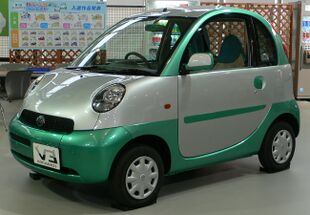Engineering:Toyota eCom
| Toyota eCom | |
|---|---|
 | |
| Overview | |
| Manufacturer | Toyota |
| Assembly | Japan |
| Dimensions | |
| Length | 2790 mm |
| Width | 1475 mm |
| Height | 1605 mm |
| |uk|Kerb|Curb}} weight | 770 kg |
The Toyota eCom was an electric vehicle (EV) that Toyota first demonstrated at the 1997 Tokyo Motor Show.[1][2] The premise of the eCom was not to be just a small car, but a car available to everybody that had a special electronic card instead of a key, promoting carpooling. It was seen in various car shows and demonstrations in three color schemes, one being white with blue fringes, another gold with blue fringes and the third very similar to the first with green-blue fringes.
Thirty eComs were made and stations were set up for rental in Toyota City[3] as part of the Toyota Canyon project[4][5] and an additional twenty were rented to the Tama New Town experimental community transportation project near Tokyo.[3] Thirty are still in use.
Toyota Motor Sales USA joined with the University of California, Irvine[6][7] and other partners to demonstrate the shared use of electric cars utilizing the eCom, Toyota's 2-passenger personal transport EV. Participants include companies located in University Research Park, a commercial park next to the university. Along with sharing cars, the "Living Power Park Laboratory" will investigate breakthrough concepts in urban design, electricity generated by stationary fuel cells, and use of a micro power grid to distribute electricity. A fleet of e-coms were used for short-distance shared-usage driving and commuting.
The eCom and cars like it were pulled from Toyota's widespread lineup not long after for financial reasons.
References
- ↑ "Toyota Virtual Museum: Stepping toward the future". http://www.toyota.co.jp/Museum/data_e/a03_12_1.html. Retrieved 2009-07-08.
- ↑ "Toyota: Global Vision 2020". 2004. Archived from the original on 2009-06-05. https://web.archive.org/web/20090605074825/http://www.toyotatr.com/eng/gvision2010.asp. Retrieved 2009-07-08.
- ↑ 3.0 3.1 Yamaguchi, Jack (June 2000). "Global Viewpoints: Shrinking electric cars". Automotive Engineering International Online. http://www.sae.org/automag/globalview_06-00/01.htm. Retrieved 2009-07-08.
- ↑ "Toyota Writes History With 'Crayon' Commuter System" (Press release). UK: Toyota. 1999-04-15. Retrieved 2017-05-21.
- ↑ "toyota e-com" (in Japanese). Toyota Automobile Museum magazine (Japan: Toyota) (80): 5. March 2010. http://www.toyota.co.jp/Museum/kandayori/backnumber/magazine80/magazine80_all.pdf. Retrieved 2017-05-21.
- ↑ "Zeroing in on Irvine: ZEV station cars provide a living lab for ITS researchers". Review Online. Institute of Transportation Studies. July 2002. http://www.its.berkeley.edu/itsreview/ITSReviewonline/july2002/Review.1.IrvineZEV.pdf. Retrieved 2009-07-08.
- ↑ Motavalli, Jim (2002-05-14). "Cadi CTS & Toyota e-com: Worlds Apart". Electrifying Times. http://www.electrifyingtimes.com/cadi_ecom.html. Retrieved 2009-07-08.

